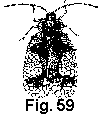 Zoom Fig.
59: Full view, Azalea lace bug. A, Adult. B,egg. C, D, E, nymphs.
Zoom Fig.
59: Full view, Azalea lace bug. A, Adult. B,egg. C, D, E, nymphs.
Return to: MREC Home Page Return to: Key to Bugs
DESCRIPTION
Adult- The adult is 3 mm long and 1.5 mm wide, dark in color with a hoodlike covering on the head and netted, lacy, off-white wings with brown or black markings. The wings are folded flat over the abdomen. The legs and antennae are light brown.
Eggs- The small (0.8 by 0.4 mm), smooth, white egg is oval with the neck to one side. It is usually deposited in the tissue of the leaf along the midrib or a large vein. In some cultivars, the eggs are deposited along the leaf margins. The eggs are inserted with the neck slightly above the leaf surface, and they are covered with a "flyspeck" of blackish frass.
Nymph- Found almost exclusively on the underside of the leaf, the nymph is colorless at birth but soon turns black and spiny. Nymphs pass through five nymphal instars before molting into the adult stage. They grow from 0.4 to 1.8 mm. Wingpads develop after the fourth instar.
Fig. 59. Azalea lace bug, Stephanitis pyrioides
(Scott), Tingidae, HEMIPTERA
 Zoom Fig.
59: Full view, Azalea lace bug. A, Adult. B,egg. C, D, E, nymphs.
Zoom Fig.
59: Full view, Azalea lace bug. A, Adult. B,egg. C, D, E, nymphs.
BIOLOGY
Distribution- In the United States, the azalea lace bug occurs from New York to Massachusetts southward to Florida and west to Texas.
Host Plants- The evergreen azalea cultivars are the preferred hosts of azalea lace bugs, although deciduous cultivars may be attacked as well as mountain laurel and rhododendrons.
Damage- Injury is caused by the adults and nymphs as they feed through piercing, sucking mouthparts. They extract the liquid contents of the leaf tissue through the undersurface. The upper surface of infested leaves become stippled or blanched, and in severe infestations, leaves gradually turn gray to white and eventually may dry up and fall. The undersurface becomes rust colored and covered with dark spots ("varnish spots") of tarlike excrement. Cast skins of nymphs are often observed on the undersurfaces. Damage usually begins on the lower leaves and moves upward.
Life History- Since its introduction from Japan in the 1920s, the azalea lace bug has become the most serious pest of azaleas. Females lay groups of eggs along the midribs of leaves, along the larger veins (and along the margins of some cultivars) on the undersurface. Females deposit eggs over a 2to 3-month period. The eggs hatch in about 2 weeks and the nymphs develop through five stages. Newly hatched nymphs are colorless but gradually turn black. Depending on temperatures, nymphs take 10 to 21 days to develop into adults. With such a long egg-laying period, it is common to see all life stages at any time during the growing season. Outdoors there are four generations produced each year. The egg is the usual overwintering stage, although in mild winters adults survive to lay eggs the following spring. In the south eggs begin hatching in late February producing dense populations in March, April, and May. A second generation occurs in July, August, or September, depending on location. This generation lays the overwintering eggs in October. In the greenhouse, azalea lace bugs can appear in large numbers in early spring and occur throughout the spring, summer, and into the fall.
CONTROL
Insecticides may be required for effective control. A predaceous plant bug, Stethoconus japonicus Schumacher, from Maryland and New York has been reported to feed voraciously on azalea lace bugs in landscapes. Perhaps some time in the near future Stethoconus japonicus may contribute to effective management of azalea lace bugs throughout the southern United States.
Control can be accomplished if the life cycles are broken early. Sprays should be timed for the first appearance of adults or nymphs in the spring just after the blooms have faded. Two applications or more may be needed because of the extended oviposition time. Systemic insecticides are most effective, and one application may suffice. Nonsystemic insecticides require thorough coverage of the undersurfaces of the foliage, and several applications may be required for complete control. Once damage has occurred, control of the lace bugs will not correct their injury. For specific chemical controls, see the current Cooperative Extension publications on ornamental plant pests or contact your local county Extension agent.
University of Florida/IFAS Reference to Pest Control Guides